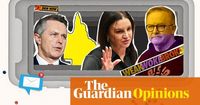In a dramatically evolving political landscape, a recent YouGov poll reveals that Prime Minister Anthony Albanese maintains his position as the preferred leader over Opposition Leader Peter Dutton by a margin of 45% to 40%. As the federal election draws closer, the competition is undeniably heating up, with both major parties engaged in a neck-and-neck race, currently tied at 50% each in the two-party preferred vote according to the survey conducted between March 14th and March 19th, 2025. This tight contest serves as a crucial context for both Albanese and Dutton, whose party lines reflect distinct political ideologies and approaches to governance.
The YouGov survey highlights that Labor's primary vote remains stable at 31%, while the Coalition has made incremental gains, posting a 37% standing after an increase of one percentage point. Meanwhile, the Greens and One Nation have seen a slight decrease in voter support, currently polling at 13% and 7% respectively, in line with recent trends wherein the Independents now hold an 8% share, albeit down by one percentage point. The survey indicates that the Trumpets of Patriots party remains stagnant at 1%, while the other parties have marginally risen to 3%.
According to Paul Smith, Director of Public Data at YouGov, these polling results suggest a highly competitive electoral environment. Smith stated, “The election is evenly poised with the two-party preferred vote split at 50%-50%, but Anthony Albanese has consolidated his lead as Prime Minister with 45% support.” Just as significant as the voting metrics are the satisfaction ratings for both party leaders, which point to a larger narrative of public sentiment.
Albanese's net satisfaction rating currently stands at -9%, calculated from a 41% satisfaction rate against 50% dissatisfaction. In contrast, Dutton's net satisfaction rating appears slightly better at -5%, drawing from 42% satisfied responses compared to 47% dissatisfied. This insight into public opinion showcases the precarious position both leaders find themselves in as they navigate an evolving electoral landscape.
The timing of this poll comes as the Albanese government prepares to release its fourth federal budget, a document widely anticipated since Australia has enjoyed back-to-back surpluses in prior years. However, financial forecasts point towards a pending deficit; hence, many analysts believe the budget may be a stepping stone towards an imminent election call. Albanese is expected to announce the election in the wake of the budget's release, possibly within days.
While the Labor party is positioning itself for an electoral showdown, the opposition is also capitalizing on tools that are becoming increasingly influential in modern campaigning—social media platforms, especially TikTok.
Both Albanese and Dutton launched their personal TikTok accounts independently of their respective parties last year, aiming to leverage the platform's potent reach among younger voters. An expert from Griffith University, Dr. Susan Grantham, observes that Albanese appears to be more adept at utilizing TikTok's engaging format. Currently, Albanese, with around 23,000 followers and 269,000 likes across 42 videos, is perceived as resonating with the platform's youthful audience more effectively than Dutton, who has 29,000 followers and a larger total of 383,000 likes across just 16 videos.
Grantham noted how TikTok is reshaping political interactions, stating, “The power of TikTok as a campaign platform can't be denied, but the effectiveness in shifting electoral decisions remains to be seen.” Albanese's approach fits the platform's style well. He embraces a lighthearted and relatable style that appeals to viewers, contrasting with Dutton’s traditional and formal persona. This disparity in their TikTok strategies highlights the broader differences in their political branding.
As political advertising intensifies, groups like Advance are preparing to ramp up their agenda with a new campaign showcasing what they describe as Albanese's failures. Executive Sandra Bourke announced that full-page ads will appear in Australia’s major newspapers. This development indicates a notable pivot from their previous emphasis on the Greens, illustrating the shifting dynamics as the election draws near. In a strategic fundraising move, former fund manager Simon Fenwick is matching donations to the group, aiming to galvanize financial support up to $200,000 throughout March.
Andrew Bolden of Environmental Climate 200 also began promoting Jacqui Lambie's stronger quotes in a series of ads intended to reinforce the independent candidate's profile amid the brewing competition. All these efforts reflect the growing importance of campaign financing and the dynamic strategies employed by political factions to combat their counterparts.
As the election approaches, particular electorates, such as Leichhardt, are under scrutiny. Initially seen as a vulnerable seat for the LNP following the retirement of longstanding member Warren Entsch, recent reports suggest that Albanese's attempts to secure support in Queensland are diminishing.
Amidst this environment, the contrasting methodologies and messaging strategies adopted by Albanese and Dutton will play a critical role as the electorate evaluates its options. Despite the tightening race based on polling figures, both leaders grapple with complex voter sentiments, ultimately reflecting a broader national sentiment navigating pivotal political themes.
The upcoming weeks and the subsequent budget will reveal further developments in this unfolding political saga, necessitating a vigilant watch over both parties as voters prepare to cast their ballots ahead of the looming election deadline and unnecessary strife over multi-faceted issues.







